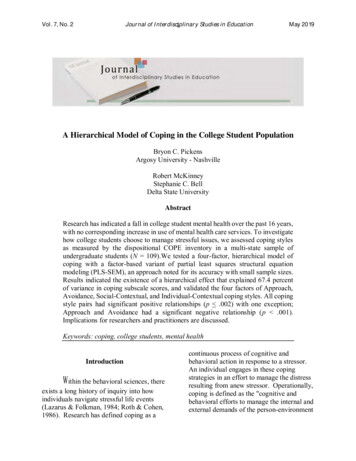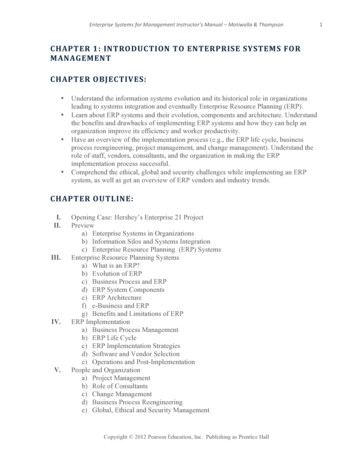
Transcription
Coping with Guilt & Shame IntroductionCopingCopingwithwithGuilt & ShameGuiltworkbook& ShameworkbookFacilitator ReproducibleGuided Self-ExplorationActivitiesFacilitator ReproducibleGuided Self-ExplorationEster A. LeutenbergActivities& John J. Liptak, Ed.D.Ester A. LeutenbergIllustrated by Amy L. Brodsky, lisw-s& John J. Liptak, Ed.D.Illustrated by Amy L. Brodsky, lisw-sDuluth, Minnesota 2013 WHOLE PERSON ASSOCIATES, 101 WEST 2ND ST., SUITE 203, DULUTH MN 55802 800-247-6789i
Coping with Guilt & Shame IntroductionWhole Person101 West 2nd St., Suite 203Duluth, MN son.comCoping with Guilt & Shame WorkbookFacilitator Reproducible Guided Self-Exploration ActivitiesCopyright 2013 by Ester A. Leutenberg and John J. Liptak.All rights reserved. Except for short excerpts for review purposesand materials in the assessment, journaling activities, andeducational handouts sections, no part of this book may bereproduced or transmitted in any form by any means, electronicor mechanical without permission in writing from the publisher.Self-assessments, exercises, and educational handouts are meantto be photocopied.All efforts have been made to ensure accuracy of the informationcontained in this book as of the date published. The author(s)and the publisher expressly disclaim responsibility for anyadverse effects arising from the use or application of theinformation contained herein.Printed in the United States of America10 9 8 7 6 5 4 3 2 1Editorial Director: Carlene SippolaArt Director: Joy Morgan DeyLibrary of Congress Control Number: 2012950508ISBN: 978-1-57025-268-6ii 2013 WHOLE PERSON ASSOCIATES, 101 WEST 2ND ST., SUITE 203, DULUTH MN 55802 800-247-6789
Coping with Guilt & Shame IntroductionUsing This BookA little bit of stress can be good for everyone’s well-being. It stimulates people to meet theirchallenges and handle unexpected emergencies. Positive stress (eustress) has been provento help people reach their full potential. However, too much stress (distress) can have theopposite effect and actually impede both physical and mental health and overall wellness.Distress can manifest itself through early warning signs (distress symptoms). Researchsuggests that when people face constant stressors and unwanted changes, they becomeemotionally upset and experience a variety of negative feelings. With repeated exposure,people experience the chronic overload of emotional stress. Two of the most commondistress emotions are guilt and shame. Guilt reminds us of the wrong deeds we’ve done,or perceived that we have done, and shame tells us that we feel embarrassed, remorseful,or even disgraced. All people feel guilt and shame in their life and both emotions can bedifficult to cope with.GuiltGuilt, a very common type of emotional distress, can be described as a feeling that involvesself-blame and a sense of responsibility for a regretted action or thought. People experienceguilty feelings with regret and self-reproach over the belief that they have done, or will do,something wrong or inadequately. Guilt often results from the perception of falling shortof self-expectations or the expectations of others. Like many feelings, guilt is often based onirrational thoughts, not facts. Feelings of guilt are usually associated with self-talk statements such as “I shouldhave,” “If I would have,” and “I could have.” Guilt can be a feeling people experience when they do something judged by theirmoral code to be wrong. This self-awareness is healthy and promotes self-reflectionand positive growth. A person’s moral code, the differentiation of intentions,decisions, and actions between those that are good (or right) and those that arebad (or wrong) is so strong that feelings of guilt can occur when the person has anurge or thinks about doing something against it. Guilt can be both healthy and unhealthy. Healthy guilt keeps people functioningin socially acceptable ways and is often associated with a conscience or moralcode. Unhealthy guilt occurs when people establish unreasonably highstandards for themselves and then feel guilty when they are unable to maintainthese standards or when they perseverate on little things that don’t meet theirpersonal standard. Two distinctive forms of guilt exist: perceived guilt and justified guilt. Perceivedguilt is when a person feels guilty even though he/she had no or little controlover something that happened, or when a person negatively interprets theconsequences of his/her actions. On the other hand, justified guilt emerges whenthe facts of a situation justify the person’s feelings of regret and guilt. 2013 WHOLE PERSON ASSOCIATES, 101 WEST 2ND ST., SUITE 203, DULUTH MN 55802 800-247-6789iii
Coping with Guilt & Shame IntroductionShameShame is a basic part of being human. Shame can be described as a sense of inadequacyabout who you are, how you behave and what you value. It is a negative emotionthat people experience when they are feeling embarrassed, humiliated or disgraced,especially in the eyes of important people in their life. Shame is based on an image thatpeople internalize of what is expected of them by others, or of themselves, and then theperception that they have fallen short in another’s, or their own, eyes. Shame can beincapacitating and injurious to people’s physical and emotional health, self-esteemand well-being. People experiencing shame will tend to hide or avoid others in order to lessen thedamage of their image in the eyes of other people. Shame tends to be born of fears and drives people to want to hide or protectthemselves from feeling or appearing inadequate. When shamed, people feel alone and outside of the rest of society. If shame isacknowledged, accepted and dealt with, it can be overcome. Two distinct forms of shame are inadequacy and self-disapproval.Shame can also be experienced when people feel embarrassed, inadequate,defective, contemptible or dishonorable. Self-disapproval shame occurs whenpeople have painful feelings about themselves because of things they havethought or done.Many people spend a great deal of their lives living with guilt and shame. It is importantfor them to deal with the emotions, thoughts and actions related to both guilt and shamein order to lead a more stress-free, calm and satisfying life. The Coping with Guilt andShame Workbook provides assessments and self-guided activities to help participantslearn useful skills for coping with various forms of guilt and shame. A variety of selfexploration activities are provided for participants to determine which best suit theirunique needs.iv 2013 WHOLE PERSON ASSOCIATES, 101 WEST 2ND ST., SUITE 203, DULUTH MN 55802 800-247-6789
Coping with Guilt & Shame IntroductionFormat of BookThe Coping with Guilt and Shame Workbook contains assessments and guided selfexploration activities that can be used with a variety of populations to help participantscope more effectively with the various aspects of guilt and shame. Each chapter of thisworkbook begins with an annotated Table of Contents with notes and examples for thefacilitator. Each chapter contains two primary elements: 1) a set of assessments to helpparticipants gather information about themselves in a focused situation, and 2) a set ofguided self-exploration activities to help participants process information and learn waysof coping with guilt and shame.AssessmentsEach chapter begins with an assessment that provides participants with valuableinformation about themselves. These assessments help identify patterns of behavior andlife skills which are productive and unproductive, and encourage development of anawareness of ways to interact with the world. Assessments provide a path to self-discoverythrough the participants’ exploration of their own unique traits and behaviors. Thepurpose of these assessments is not to “pigeon-hole” people, but to allow them to explorevarious elements that are critical for coping with guilt and shame. This book contains selfassessments and not tests. Traditional tests measure knowledge or right or wrong responses.For the assessments provided in this book, remind participants that there are no right orwrong answers. These assessments ask only for opinions or attitudes about topics relatedto a variety of coping skills and abilities.The assessments in this book are based on self-reported data. In other words, the accuracyand usefulness of the information is dependent on the information that participantshonestly provide about themselves. All of the assessments in this workbook are designedto be administered, scored, and interpreted by the participants as a starting point for themto begin to learn more about themselves and their coping skills. Remind participantsthat the assessments are exploratory exercises and not a final determination of abilities.Lastly, the assessments are not a substitute for professional assistance. If you feel any ofyour participants need more assistance than you can provide, please refer them to anappropriate professional.As your participants begin the assessments in this workbook give these instructions: Take your time. Because there is no time limit for completing the assessments, work atyour own pace. Allow yourself time to reflect on your results and how they compare towhat you already know about yourself. Do not answer the assessments as you think others would like you to answer them orhow you think others see you. These assessments are for you to reflect on your life andexplore some of the barriers that are keeping you from living a calmer, more rationaland less anxious life.(Continued on the next page) 2013 WHOLE PERSON ASSOCIATES, 101 WEST 2ND ST., SUITE 203, DULUTH MN 55802 800-247-6789v
Coping with Guilt & Shame IntroductionFormat of Book (Continued) Assessments are powerful tools if you are honest with yourself. Take your time and betruthful in your responses so that your results are an honest reflection of you. Your levelof commitment in completing the assessments honestly will determine how much youlearn about yourself. Before completing each assessment, be sure to read the instructions. The assessmentshave similar formats, but they have different scales, responses, scoring instructions andmethods for interpretation. Finally, remember that learning about yourself should be a positive and motivatingexperience. Don’t stress about taking the assessments or discovering your results. Justrespond honestly and learn as much about yourself as you can.Guided Self-Exploration ActivitiesGuided self-exploration activities are any exercises that assist participants in self-reflectionand enhance self-knowledge, identify potential ineffective behaviors, and teach moreeffective ways of coping. Guided self-exploration is designed to help participants make aseries of discoveries that lead to increased social and emotional competencies, as well as toserve as an energizing way to help participants grow personally and professionally. Thesebrief, easy-to-use self-reflection tools are designed to promote insight and self-growth.Many different types of guided self-exploration activities are provided for you to pick andchose the activities most needed by your participants and / or will be most appealing tothem. The unique features of self-guided exploration activities make them usable andappropriate for a variety of individual sessions and group sessions.Features of Guided Self-Exploration Activities Quick, easy and rewarding to use — These guided self-exploration activitiesare designed to be an efficient, appealing method for motivating participants toexplore information about themselves — including their thoughts, feelings, andbehaviors — in a relatively short period of time. Reproducible – Because the guided self-exploration activities can be reproducedby the facilitator, no more than the one book needs to be purchased. You mayphotocopy as many items as you wish for your participants. If you want to add ordelete words on a page, make one photocopy, white out and / or write your ownwords, and then make photocopies from your personalized master. Participative — These guided self-exploration activities help people to quicklyfocus their attention, aid them in the self-reflection process, and learn new andmore effective ways of coping.(Continued on the next page)vi 2013 WHOLE PERSON ASSOCIATES, 101 WEST 2ND ST., SUITE 203, DULUTH MN 55802 800-247-6789
Coping with Guilt & Shame IntroductionFormat of Book (Continued) Motivating to complete — The guided self-exploration activities are designed tobe an energizing way for participants to engage in self-reflection and learn aboutthemselves. Various activities are included to enhance the learning process relatedto developing important social and emotional competency skills. Low risk — The guided self-exploration activities are designed to be less riskythan formal assessments and structured exercises. They are user-friendly, andparticipants will generally feel rewarded and motivated after completing theseactivities. Adaptable to a variety of populations — The guided self-exploration activitiescan be used with many different populations and can be tailored to meet theneeds of the specific population with whom you work. Focused — Each guided self-exploration activity is designed to focus on a singlecoping issue, thus enhancing the experience for participants. Flexible — The guided self-exploration activities are flexible and can be usedindependently or to supplement other types of interventions. 2013 WHOLE PERSON ASSOCIATES, 101 WEST 2ND ST., SUITE 203, DULUTH MN 55802 800-247-6789vii
Coping with Guilt & Shame IntroductionChapter ElementsThe Coping with Guilt & Shame Workbook is designed to be used either independently oras part of an integrated curriculum. You may administer any of the assessments and theguided self-exploration activities to an individual or a group with whom you are working,
self-blame and a sense of responsibility for a regretted action or thought. People experience guilty feelings with regret and self-reproach over the belief that they have done, or will do, something wrong or inadequately. Guilt often results from the perception of falling short of self-expectations or the expectations of others. Like many feelings, guilt is often based on irrational thoughts .











